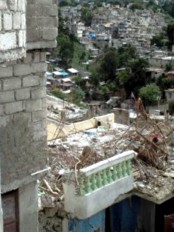|
||||||||||||||||||
|
|
Haiti - Reconstruction : (I) Housing - Strategic Plan 04/01/2011 18:30:21
While donors begin to fulfill their pledges and have difficulty accessing the facts about what is needed most on the ground, many are asking how to prioritize their spending. The strategic plan presented at the fourth meeting of the IHRC, December 14, 2010 at Santo Domingo in the Dominican Republic, will help guide the project implementers, donors and investors as they guide the disbursement of their pledges for the reconstruction and development of Haiti, and add much needed new funding. Developed jointly by the Commission, international experts and ministry leaders, this plan outlines many of the most important things needed in Haiti by October 2011, the end of IHRC’s mandate. Each day of the week we'll discover a part of this strategic plan for 2011. Today we cover the housing. The main target outcome is to reduce camp population by 400,000 people. Other outcomes will include:
Rationale : The best approach for rehousing people affected by the earthquake in Haiti will be to help as many as possible return to their original neighborhoods while progressively improving the safety and quality of life in those neighborhoods, and relocating those whose safety cannot be assured. This approach also favors interventions that allow the largest number of people to move out of camps and into improved conditions in the shortest possible time, while maintaining the social networks and livelihoods on which camp residents rely for survival. Doing this requires improving construction standards, reducing the vulnerabilities of housing sites and neighborhoods, and improving land use and expanding public services in neighborhoods. The rebuilding process should also provide economic opportunities in construction and related fields and be accompanied by new financing options for qualified families. Yet not all can or should return to their former living arrangements, and all households do not need the same assistance. Therefore, the reconstruction program must provide a range of shelter and housing solutions that meet the needs of the affected families and options tailored to the needs of various groups: owners and renters, the displaced and non-displaced, and urban and rural households. Many in the affected population have already moved more than once, so care must be taken to see that assistance does not result in renewed displacement (e.g. repeated relocation, rent increases, or disputes over tenancy or land). The goals are therefore to:
Required programs : The targets identified above are based on assumptions that more than 1,000 new houses can be built per month during 2011, and that more than 2,000 houses per month can be repaired. This requires the coordination of a large number of housing reconstruction actors, and the creation of a significant coordination and support system for neighborhoods and reconstruction agencies. Priority actions include:
Specific projects for 2011 include:
Funding requirements : The funding requirement to rehouse Haiti’s displace population will be enormous, but only a portion of it will be spent on housing per se. Much more will be needed to remove rubble, and to improve the conditions in neighborhoods through service improvements and risk reduction that will allow private investment in housing to take place. Original funding commitments for the housing sector totaled $174 million. Reconstruction agency funding commitments to date have focused largely on temporary shelter, so reconstruction commitments are still difficult to determine and are often provided only in terms of “number of houses”. Nevertheless, projections from a number of agencies for the overall reconstruction to date total 21,000 repairs and 15,000 new houses, against an estimated need of 23,000 repairs, 11,000 new housing units, and 160,000 improved temporary shelters in 2011 alone to reach the proposed targets. For the entire reconstruction process, approximately 90,000 houses will need to be rebuilt, and 93,000 repaired. Funding needed to meet the targets for 2011 alone is estimated at $350,000,000 1 of which perhaps 40% is committed by various agencies, but is programmed to be spent over a longer time period (3 to 4 years). Government must remove the impediments that are making it difficult for donors to spend the funding they have available (see below). Once that is done, agencies may then need to be encouraged to spend their funding commitments on more urgent needs, such as rubble removal, yellow house repairs, and site preparation, rather than reserving it specifically for housing construction or reconstruction. (1) This figure includes : $55 million for construction of new houses in new sites; $60 million to upgrade shelters or provide temporary housing; $30 million for new construction in existing neighborhoods $35 million for enumeration in neighborhoods $53 million for yellow house repairs $30 million for housing reconstruction in neighborhoods $52 million to return temporary services to reoccupied neighborhoods $35 million for risk mitigation in neighborhoods Policy decisions and institutional enablers There are a number of policy decisions by government that will enable housing reconstruction to proceed more rapidly : 1 - Land ownership : Issue : Lack of clarity on status of appropriated lands preventing agency interventions and encouraging land invasion Proposed Resolution : Government completes or abandons appropriations processes for land declared of public utility 2 - Tenure security : Issue : Risks for households associated with lack of security of tenure in informally settled neighborhoods Proposed Resolution : Government establishes procedures to ensure tenure rights in enumerated informal neighborhoods 3 - Registration of households : Issue : Only those in camps have been registered, causing them to stay in camps in order to be eligible for expected assistance Proposed Resolution : Registration of affected population is completed 4 - Risk management : Issue : Doubts about which neighborhoods people can safely return to Proposed Resolution : Government and donors agree on strategies for mitigating risk in neighborhoods 5 - Scaling up "building back better" : Issue : Need to greatly expand capacity to repair, retrofit, and rebuild safely, applying new building guidelines Proposed Resolution : Need for large scale government-sanctioned training program for builders, homeowners, and local governments; need for retrofitting guidelines 6 - Financial assistance : Issue : Variety of proposals but no clarity on financial assistance for households for housing Proposed Resolution : Government and donors develop a unified financial assistance strategy for households 7 - Reconstruction policy : Issue : Lack of clear policy framework for housing reconstruction slowing agency interventions and making outcomes uncertain Proposed Resolution : Government approves Neighborhood Return and Housing Reconstruction framework Interdependence with other sectors : Housing and neighborhood reconstruction is not a single sector, but instead combines interventions in several IHRC sectors, including water and sanitation, disaster risk reduction, job creation, health, and education, among others. Housing decisions are also strongly influenced by decisions made about investments in other sectors such as transport. Therefore, close coordination is needed among other sectors and housing and neighborhood investments. This will be particularly important, for instance, when households are relocated from camps. In order to make it feasible for families to return, projects sponsors will need to ensure that there is safe drinking water, sanitary conditions, and health and education services operating in these neighborhoods. Without this coordination, families may choose to remain in the camps. See also: https://www.haitilibre.com/en/news-2040-haiti-reconstruction-ii-debris-removal-and-management-strategic-plan.html https://www.haitilibre.com/en/news-2047-haiti-reconstruction-iii-education-strategic-plan.html https://www.haitilibre.com/en/news-2054-haiti-reconstruction-iv-health-strategic-plan.html https://www.haitilibre.com/en/news-2062-haiti-reconstruction-v-energy-strategic-plan.html https://www.haitilibre.com/en/news-2066-haiti-reconstruction-vi-job-creation-strategic-plan.html https://www.haitilibre.com/en/news-2073-haiti-reconstruction-vii-water-and-sanitation-strategic-plan.html https://www.haitilibre.com/en/news-2082-haiti-reconstruction-viii-reinforcement-of-institutions-strategic-plan.html HL/ S/ HaïtiLibre /CIRH
|
|
|
Why HaitiLibre ? |
Contact us |
Français
Copyright © 2010 - 2024 Haitilibre.com |



